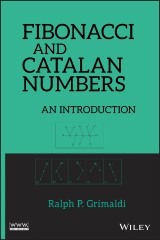Details

Fibonacci and Catalan Numbers
An Introduction1. Aufl.
|
102,99 € |
|
| Verlag: | Wiley |
| Format: | EPUB |
| Veröffentl.: | 21.02.2012 |
| ISBN/EAN: | 9781118159767 |
| Sprache: | englisch |
| Anzahl Seiten: | 380 |
DRM-geschütztes eBook, Sie benötigen z.B. Adobe Digital Editions und eine Adobe ID zum Lesen.
Beschreibungen
<b>Discover the properties and real-world applications of the Fibonacci and the Catalan numbers</b><br /> <br /> <p>With clear explanations and easy-to-follow examples, Fibonacci and Catalan Numbers: An Introduction offers a fascinating overview of these topics that is accessible to a broad range of readers.</p> <p>Beginning with a historical development of each topic, the book guides readers through the essential properties of the Fibonacci numbers, offering many introductory-level examples. The author explains the relationship of the Fibonacci numbers to compositions and palindromes, tilings, graph theory, and the Lucas numbers.</p> <p>The book proceeds to explore the Catalan numbers, with the author drawing from their history to provide a solid foundation of the underlying properties. The relationship of the Catalan numbers to various concepts is then presented in examples dealing with partial orders, total orders, topological sorting, graph theory, rooted-ordered binary trees, pattern avoidance, and the Narayana numbers.</p> <p>The book features various aids and insights that allow readers to develop a complete understanding of the presented topics, including:</p> <ul> <li> <p>Real-world examples that demonstrate the application of the Fibonacci and the Catalan numbers to such fields as sports, botany, chemistry, physics, and computer science</p> </li> <li> <p>More than 300 exercises that enable readers to explore many of the presented examples in greater depth</p> </li> <li> <p>Illustrations that clarify and simplify the concepts</p> </li> </ul> <p>Fibonacci and Catalan Numbers is an excellent book for courses on discrete mathematics, combinatorics, and number theory, especially at the undergraduate level. Undergraduates will find the book to be an excellent source for independent study, as well as a source of topics for research. Further, a great deal of the material can also be used for enrichment in high school courses.</p>
<p>Preface xi</p> <p><b>Part One The Fibonacci Numbers</b></p> <p>1. Historical Background 3</p> <p>2. The Problem of the Rabbits 5</p> <p>3. The Recursive Definition 7</p> <p>4. Properties of the Fibonacci Numbers 8</p> <p>5. Some Introductory Examples 13</p> <p>6. Compositions and Palindromes 23</p> <p>7. Tilings: Divisibility Properties of the Fibonacci Numbers 33</p> <p>8. Chess Pieces on Chessboards 40</p> <p>9. Optics, Botany, and the Fibonacci Numbers 46</p> <p>10. Solving Linear Recurrence Relations: The Binet Form for <i>F<sub>n </sub></i>51</p> <p>11. More on <i>α </i>and <i>β</i>: Applications in Trigonometry, Physics, Continued Fractions, Probability, the Associative Law, and Computer Science 65</p> <p>12. Examples from Graph Theory: An Introduction to the Lucas Numbers 79</p> <p>13. The Lucas Numbers: Further Properties and Examples 100</p> <p>14. Matrices, The Inverse Tangent Function, and an Infinite Sum 113</p> <p>15. The gcd Property for the Fibonacci Numbers 121</p> <p>16. Alternate Fibonacci Numbers 126</p> <p>17. One Final Example? 140</p> <p><b>Part Two The Catalan Numbers</b></p> <p>18. Historical Background 147</p> <p>19. A First Example: A Formula for the Catalan Numbers 150</p> <p>20. Some Further Initial Examples 159</p> <p>21. Dyck Paths, Peaks, and Valleys 169</p> <p>22. Young Tableaux, Compositions, and Vertices and Arcs 183</p> <p>23. Triangulating the Interior of a Convex Polygon 192</p> <p>24. Some Examples from Graph Theory 195</p> <p>25. Partial Orders, Total Orders, and Topological Sorting 205</p> <p>26. Sequences and a Generating Tree 211</p> <p>27. Maximal Cliques, a Computer Science Example, and the Tennis Ball Problem 219</p> <p>28. The Catalan Numbers at Sporting Events 226</p> <p>29. A Recurrence Relation for the Catalan Numbers 231</p> <p>30. Triangulating the Interior of a Convex Polygon for the Second Time 236</p> <p>31. Rooted Ordered Binary Trees, Pattern Avoidance, and Data Structures 238</p> <p>32. Staircases, Arrangements of Coins, The Handshaking Problem, and Noncrossing Partitions 250</p> <p>33. The Narayana Numbers 268</p> <p>34. Related Number Sequences: The Motzkin Numbers, The Fine Numbers, and The Schröder Numbers 282</p> <p>35. Generalized Catalan Numbers 290</p> <p>36. One Final Example? 296</p> <p>Solutions for the Odd-Numbered Exercises 301</p> <p>Index 355</p>
<p><b>RALPH P. GRIMALDI, P<small>H</small>D,</b> is Professor of Mathematics at Rose-Hulman Institute of Technology. With more than forty years of experience in academia, Dr. Grimaldi has published numerous articles in discrete mathematics, combinatorics, and graph theory. Over the past twenty years, he has developed and led mini-courses and workshops examining the Fibonacci and the Catalan numbers.
<p><b>Discover the properties and real-world applications of the Fibonacci and the Catalan numbers</b> <p>With clear explanations and easy-to-follow examples, <i>Fibonacci and Catalan Numbers: An Introduction</i> offers a fascinating overview of these topics that is accessible to a broad range of readers. <p>Beginning with a historical development of each topic, the book guides readers through the essential properties of the Fibonacci numbers, offering many introductory- level examples. The author explains the relationship of the Fibonacci numbers to compositions and palindromes, tilings, graph theory, and the Lucas numbers. <p>The book proceeds to explore the Catalan numbers, with the author drawing from their history to provide a solid foundation of the underlying properties. The relationship of the Catalan numbers to various concepts is then presented in examples dealing with partial orders, total orders, topological sorting, graph theory, rooted-ordered binary trees, pattern avoidance, and the Narayana numbers. <p>The book features various aids and insights that allow readers to develop a complete understanding of the presented topics, including: <ul> <li><b>Real-world examples</b> that demonstrate the application of the Fibonacci and the Catalan numbers to such fields as sports, botany, chemistry, physics, and computer science</li> <li><b>More than 300 exercises</b> that enable readers to explore many of the presented examples in greater depth</li> <li><b>Illustrations</b> that clarify and simplify the concepts</li> </ul> <p><i>Fibonacci and Catalan Numbers</i> is an excellent book for courses on discrete mathematics, combinatorics, and number theory, especially at the undergraduate level. Undergraduates will find the book to be an excellent source for independent study, as well as a source of topics for research. Further, a great deal of the material can also be used for enrichment in high school courses.

















